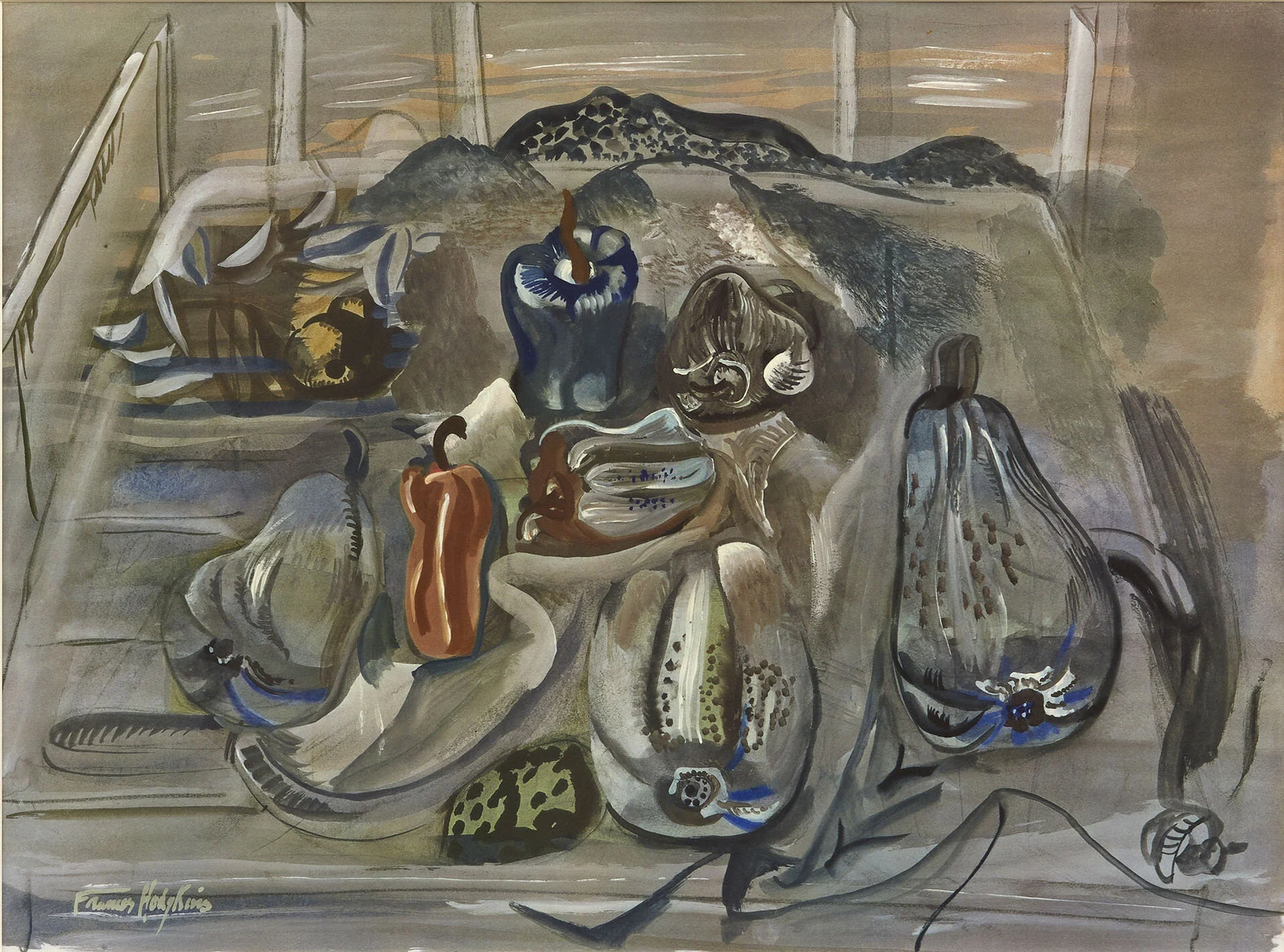Frances Hodgkins
Pumpkins, 1952
Collotype, 52 x 70 cm
Published by Ganymed, 1952 from the 1935 gouache
The image used to produce the present original collotype “Pumpkins” is that of the gouache Pumpkins and Pimenti (circa 1935) owned at the time by Sir Kenneth Clark, Director of the National Gallery, and now held in the collection of The Fletcher Trust.
With financial assistance from Rée Gorer and Dorothy Selby, Frances Hodgkins spent the winter of 1935 – 36 in Tossa de Mar where she painted the gouache Pumpkins and Pimenti which is closely related to Marrows a work that featured in the 2019 Jonathan Grant Galleries exhibition Frances Hodgkins – A New Zealand Modernist.
Frances Hodgkins to Dorothy Selby. Casa Steyer Tossa de Mar Gerona Spain Nov 1935
I paint during the morning – dividing my time inside & outside the Studio. This is the very charming part of a place like Tossa. So small & simple one can step into the old streets and have a look round – make a quick sketch & back to the Studio. Repeating this little stunt perhaps 2-3 times during the morning – no fatigue – no complications. I am mildly happy here as regards work. Subjects have come slowly. I still think it rather a middling sort of place ideal in summer – for a good time & holiday
In the present work, the pencil under-drawing is clearly visible and the addition of chalk and small areas of bright colour over the gouache add lustre and definition to the image.
By the time she made this picture, still life had become one of Hodgkins’ favourite types of composition, and this is one of her most distinguished in that genre. The use of vegetables as a substitute for flowers and ceramic vases is reminiscent of her ‘still life in a landscape’ series of paintings although the colour tones are more muted and the landscape is less defined in the present work which allows the blues on the central pepper and the red of the foreground pepper to stand out in the composition giving a feeling of that of an earlier work by Georges Braque.
Pumpkins and Pimenti was purchased by Sir Kenneth Clark, at that time a leading light in the British art establishment, and selected for the Penguin monograph on Hodgkins that Myfanwy Evans submitted for the artist’s approval before publication (Frances Hodgkins, 1948), indicates the esteem that the artist herself and her contemporaries put on this work.
This standing is endorsed by the work’s inclusion in the project that gave it the form seen here: these Ganymed Facsimiles reproduced original artworks in colour collotype of a sufficient quality “for display in Art Galleries, Museums, Universities, etc., throughout the world”. The company provided specially designed frames to enhance the works’ artistic effect, and the Tate Gallery was happy to put its name to them. Hodgkins was included in the second list offered, whose thirty-one artists ran from William Blake to Pablo Picasso.
The emergence of the present work calls for a revision of the often-heard remark that Arrangement of Jugs (lithograph, 1938) is Hodgkins’ only surviving print, and gives further evidence of her standing in the British artworld in the years following her death.
Linda Gill (ed.) Letters of Frances Hodgkins (Auckland University Press 1981) p. 468 #465
The Ganymed Press
The Ganymed Press were collotype printers based in London between 1947-63 (and for the two following years under Waterlow's collotype department).
The firm owed its origins to Ganymed Graphische Anstalt of Berlin, founded in the early years of the 20th century by Bruno Deja, a printer, and the art historian Julius Meier-Graefe, Director of Marées Gesellschaft, for which it printed much work.
The Berlin works was re-established after wartime bombing with the help of the British publishing firm Lund Humphries and the New Statesman newspaper; Deja, in turn, advised the London firm set up by Lund Humphries and the New Statesman and provided trained craftsmen. The London firm was established in 1947 and run by Bernhard Baer (1905-83) and his wife Anne.
From 1951 onwards the firm produced original graphic work in collotype ('collographs') in which the artist worked closely with the printer.
After the closing of the printing works in the early 60s the Ganymed Press continued to publish; it was taken over by the Medici Society in 1979.
The thirty-one subjects in this series represent the first color-collotype facsimiles produced at the new works of Ganymed Press, London. The pictures were selected for reproduction either by the trustees of the Tate Gallery, or by the British Council or by Messrs. Lund Humphries.
-
Bibliography
'Ganymed' exhibition catalogue V&A 1980 B.Baer in 'Librarium' III 1982, pp.174-200 (published in Switzerland)
-
The Collotype Process
This exacting printing process uses first a huge camera to produce a direct negative the size of the required print.
Then, as many plates are made as the printer requires to reproduce the subtleties of painting. Ten plates or more are not uncommon. Made of glass, each plate is coated in a film of gelatine which, when made light sensitive, becomes `spongy’ in varying degrees, thus holding more or less ink and eventually reproducing exactly the tonal quality of the original work.
Only capable of sustaining a small run of very high-quality prints, “Collotype” became anachronistic in the modern world and Ganymed ceased production of collotypes in the early 1960’s.
Reference
Frances Hodgkins Database FH1080
(completefranceshodgkins.com)
Illustrated
Ganymed Facsimiles, London, April 1950. p.18

